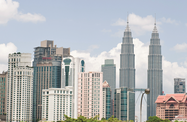Following a strong year in 2010, Malaysia’s manufacturing sector looks set for a repeat performance in 2011 in its effort to draw in foreign investment. The Malaysian Investment Development Authority (MIDA) is setting a target of bringing in RM55bn ($18.22bn) in new investment for the year.
In 2010, the manufacturing sector attracted a total of RM47.2bn ($15.64bn) in approved investments across some 910 projects, with this representing an increase in value of 44.8% from RM32.6bn ($10.8bn) and 766 projects the previous year.
According to MIDA’s director-general, Jalilah Baba, investment totalling RM14bn ($4.64bn) is already “in the pipeline” to be realised this year, and the organisation is now focusing on the oil and gas sector in particular, holding talks with major international players.
This is welcome news for the country’s broader effort to drive economic growth, which was detailed in the Economic Transformation Programme (ETP) released in October 2010. The ETP aims to achieve GDP growth of 5-6% annually over the next 10 years. This would raise Malaysia’s gross national income (GNI) above RM1trn ($331.33bn), or $15,000 per capita, by 2020. In 2009, Malaysia’s GNI was RM665m ($220.33m), or $6700 per capita. The government’s goal is to reach high-income economy status by 2020, with the World Bank classifying this as a country with a per capita income of at least $12,196.
Private sector spending is expected to drive much of this growth, with the ETP responsible for attracting investment. To this end the ETP has highlighted 131 entry point projects and 60 business opportunities under 12 National Key Economic Areas to boost private investment and create 3.3m jobs. It is banking on these entry point projects to generate an estimated RM794.5bn ($263.24bn) worth of investments, out of the total of RM1.4trn ($463.86bn) required to drive GDP growth over the next 10 years.
According to the first annual report of the Government Transformation Programme (GTP), one of a package of initiatives under the New Economic Model launched by the government a year ago, progress towards realising the ETP’s objectives has so far been strong. The report stated that the ETP had generated RM95bn ($31.48bn) worth of investment, representing 12% of its 10-year target, as of the end of March.
Speaking on the sidelines of the Invest Malaysia 2011 conference, held in mid-April in Kuala Lumpur, MIDA’s Jalilah was optimistic about attracting the investment needed to make the ETP a success. “Strategies have been put into place,” she told local media. “We are very serious about the ETP and the GTP.”
In May 2010, MIDA set up the National Committee on Investments, which became the central body for facilitating foreign capital inflows. In addition, the organisation is also taking a range of other steps to help make the country more appealing for foreign investors, including “offering investment facilitation where we [deal with] enquiries and visits for potential investors” and “handling their proposals for speedy approval”, Jalilah said. “We want to make sure there are no roadblocks to woo them here,” she added.
In terms of target markets, the focus is largely on boosting investment from China and the Middle East. In 2010 Chinese investment in the manufacturing sector totalled some RM639.5m ($211.88m), making it the ninth-largest source of foreign direct investment in the sector. According to Jalilah, the organisation is in talks with several Chinese firms regarding projects in the state of Sarawak, which has attracted particular interest from China due to its abundant power supply and available land.
With oil prices at sustained high levels, major oil producers in the Gulf region have additional funds available for overseas investment, and MIDA is stepping up efforts to tap into this. Saudi Arabia, Qatar and the UAE will be the primary focus of MIDA’s efforts to boost investment from the region, Jalilah told local media. Middle Eastern investment was RM4.6bn ($1.52bn) in 2010, primarily in the food, textiles, biotechnology and metals sectors.
Highlighting the country’s continued appeal for investors, Prime Minister Najib Razak unveiled 12 new projects in electronics, infrastructure, and oil and gas, with a total investment value of $3.7bn, in his keynote address at the Invest Malaysia 2011 conference on April 19th. “Today’s announcement shows the continued interest of investors in the ETP,” he told the press. While plenty more remains to be done to meet the government’s goals for 2020, this and other recent investment success stories are evidence of a good start for Malaysia in its move to become a high-income economy.
People also clicked:

